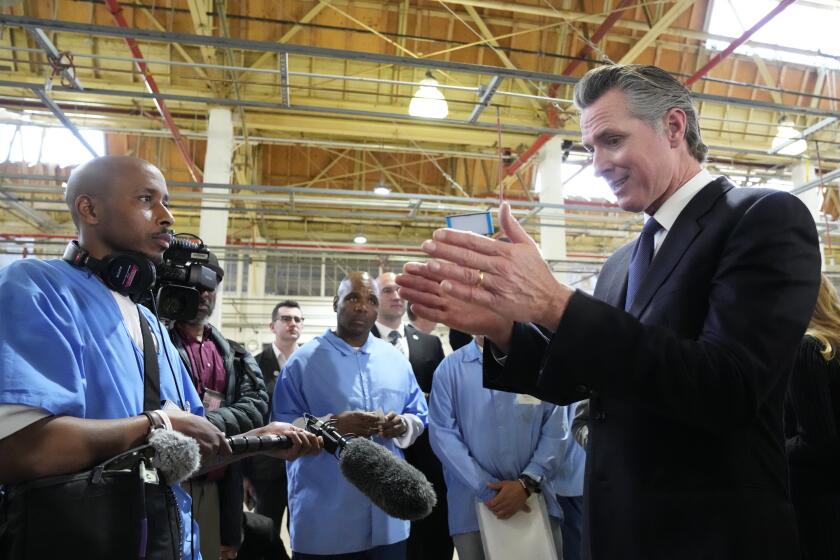Building From Bottom Up: The Importance of Neighborhood Groups
- Share via
In Chicago, neighborhood organization has moved into the streets: a gang has added a political portfolio to its operations. It is a frightening prospect, partly because it is so easy to see how this new enterprise might succeed. Gangs have ways of enforcing and rewarding consensus to achieve a goal.
In Los Angeles, the Riordan Administration is trying to create a neighborhood structure with its new Los Angeles Neighborhood Initiative. The project will spend $40 million to spruce up eight commercial neighborhoods located along public-transit routes.
We need neighborhood organizations, paradoxically enough, because large cities work only if there is a sense of belonging to a smaller community within them. That’s one of the reasons why gangs work. But is Riordan’s neighborhood initiative anything more than a cosmetic ploy at a time when we need genuine and serious experiments in community living?
It used to be that the city’s poorest neighborhoods were ethnically homogeneous. This was not just because they were made up of immigrants who had followed their families to the neighborhood. There were also restrictive covenants that barred them from settling in other parts of the city, especially if they were black, Mexican, Asian or Jewish. Yet, the perceived hostility of the outside world gave their community organizations a rough stability and strength.
Today, only East Los Angeles is a predominantly single-ethnic community. Virtually all other middle- and lower-class neighborhoods are ethnically diverse. And this diversity has made neighborhood consensus, and the institutions that grow out of it, a near-impossible dream. As a result, we struggle on our own, and as our neighborhoods change, more established community organizations typically find themselves supported by one ethnicity serving another--a situation that can lead to conflict.
The problem is that no neighborhood institution has replaced the all-inclusiveness and multipurposefulness of the party machine. Ward and precinct captains were the glue that held together coalitions of ethnic communities, produced consensus and tied people to politics. They created, among other things, a sense of neighborhood.
Religious institutions, to some extent, have tried to fill the neighborhood-organization vacuum. They are increasingly providing, through covenants among churches and synagogues, the social services that used to be the daily bread of the machines. But except for Catholic parishes and storefront churches, most of the city’s larger religious institutions are “gathering” institutions. Their membership comes together on Sunday, then scatters home to other neighborhoods.
There are institutions that immigrant communities bring with them: family and village associations, for example. They play important roles in basic survival by providing immediate economic help and by offering people the opportunity to reaffirm identities and ties strained by new environments. But they usually don’t connect their members to the city.
The best “connectors” in the new communities are the social-service agencies staffed by second-generation immigrants who can articulate and lobby for the needs of their community to the larger city. These agency heads, however, are not traditional community leaders and, as such, are unable to “deliver” their communities to form coalitions with other groups, or create linkages between their constituents and the larger civic society. Over time, some of these groups may foster community activism, but probably of the kind most associated with block clubs, whose organizing purpose may be quite narrow--getting an alley cleared, or getting neighbors to do it themselves.
The Los Angeles Neighborhood Initiative offers an opportunity to see how the communities most in need can learn to work together. It has several advantages: there is money to be dispensed, which tends to focus the mind; and it is a short-term project. Neighborhood advisory groups frequently fall apart over internal political struggles; the initiative has the resources to ease them through tensions, but each will have to listen carefully to make sure everyone is heard.
Still, we need to learn more about what makes neighborhood organizations work in the communities they serve. In so doing, we may have to deliberately blur the line separating church and state, for example. We will always need leaders--at the top and bottom of the social structure--who can help us overcome our fears and see the dreams in other people’s eyes. In the long term, that may require more than a neighborhood face lift.
More to Read
Sign up for Essential California
The most important California stories and recommendations in your inbox every morning.
You may occasionally receive promotional content from the Los Angeles Times.













